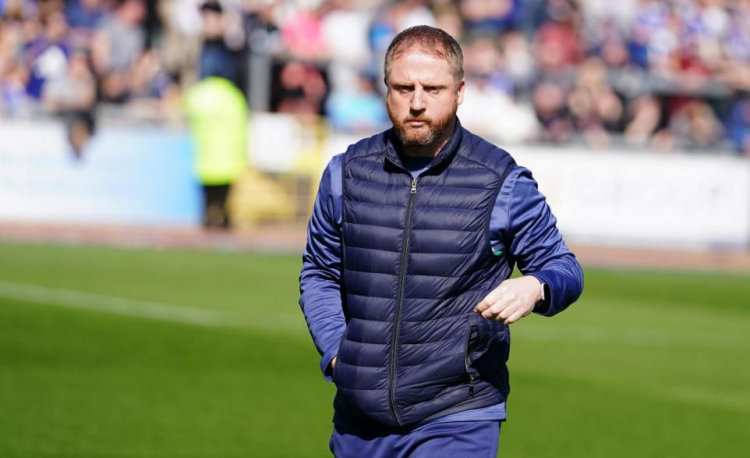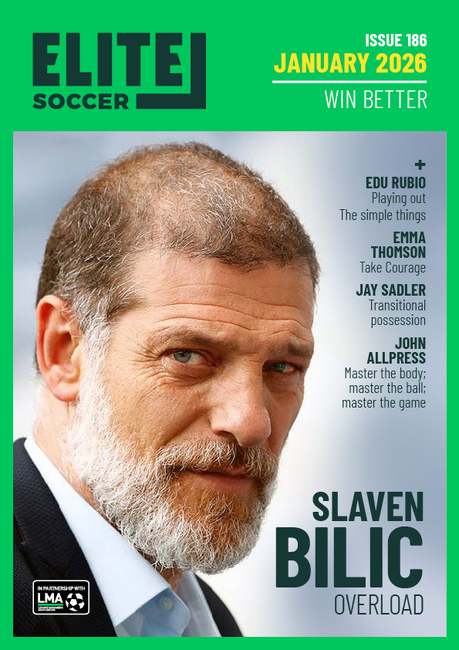




OUR BEST EVER OFFER - SAVE £100/$100
JOIN THE WORLD'S LEADING PROFESSIONAL DEVELOPMENT PROGRAMME
- 12 months membership of Elite Soccer
- Print copy of Elite Player & Coach Development
- Print copy of The Training Ground
You are viewing 1 of your 1 free articles
Playing through the mid third from the full-back
This session is delivered to give my team ideas, principles and an understanding of how to play through the mid third and enter the final third in controlled possession from a full-back.
| Area | Up to full pitch |
| Equipment | Balls, bibs, cones, mannequins, 4 full size goals |
| No. of Players | Up to 20 outfield + 4 goalkeepers |
| Session Time |
Lead-in session: timed blocks, depending on type of physical day |
This session is delivered to give my team ideas, principles and an understanding of how to play through the mid third and enter the final third in controlled possession from a full-back.
We play 4-3-3 in possession. The opposition will be set up in 5-3-2. The session involves specific movement patterns to give the full-back multiple passing options and I focus on just two phases of play.
I’ve designed this session based around the individual player’s profile and qualities within their position. So, while I always keep our style and principles of play, I adapt patterns of play tailored to the individual.
The team is selected to add balance and while the profile of players on the left side are different to the right, they all complement each other. Therefore, our patterns of play look different on both sides.
I find the players enjoy and are fully committed to this session as they understand that it’s based around their strengths. It also gives them clarity on their roles and responsibilities in this specific area of our play.
Within the session, I focus on the detail of the movement of support players to give the full-backs forward passing options.
However, I always leave the player in possession to make the decision.
I deliver the session – or a variation of the session – at least once a week. The session may be focused on a different starting player or in a different area of the pitch, depending on what I feel the team requires at that time. It will also be adjusted slightly, dependent on the upcoming opposition’s style and shape. If we were in a busy schedule - a three-game week, for example - we may just look at it in the analysis room and review from previous games or training sessions.
Before going into the session, here is a brief profile on the players, set up in our in-possession shape. This will give more understanding as to why I use certain patterns.
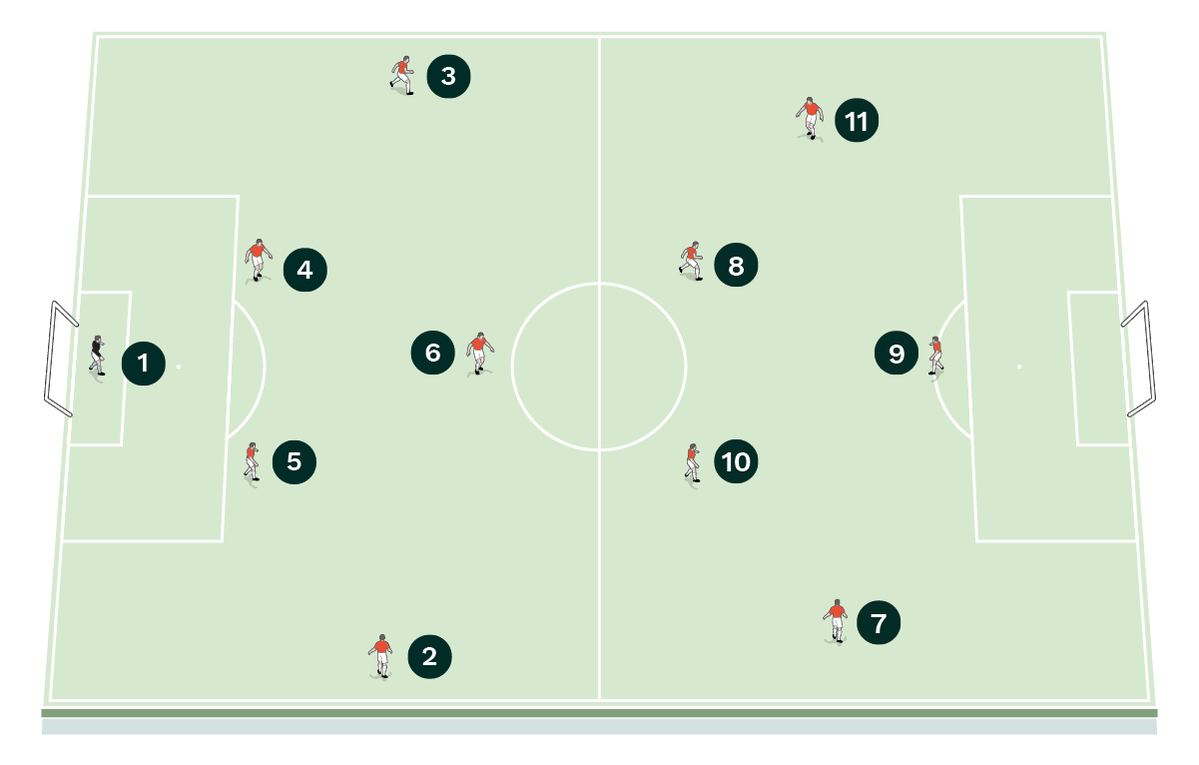
- Passing
- Technical and range of pass
- Pass and range of pass
- Passing
- Passing
- Technical and range of pass
- Pace and goal threat
- Running and goal threat
- Hold up and run behind
- Technical and ball carrier
- Technical and ball carrier
LEAD-IN SESSION
We’re using half a pitch, split down the middle, with a full size goal on each side at one end. There are ten outfield players and two goalkeepers on each side, as shown. The full-backs are doubled up on each side, so one starts off the pitch and rotates in for different passages of play. Five mannequins are set up on each side, as shown.
Play runs in parallel on both sides.
The ball starts with the goalkeeper. The goalkeeper must work with the centre backs and centre defensive midfielder to work the ball to the full-back.
In the first phase, the full-back getting possession of the ball is a trigger for specific movements from the other players.
[1a]
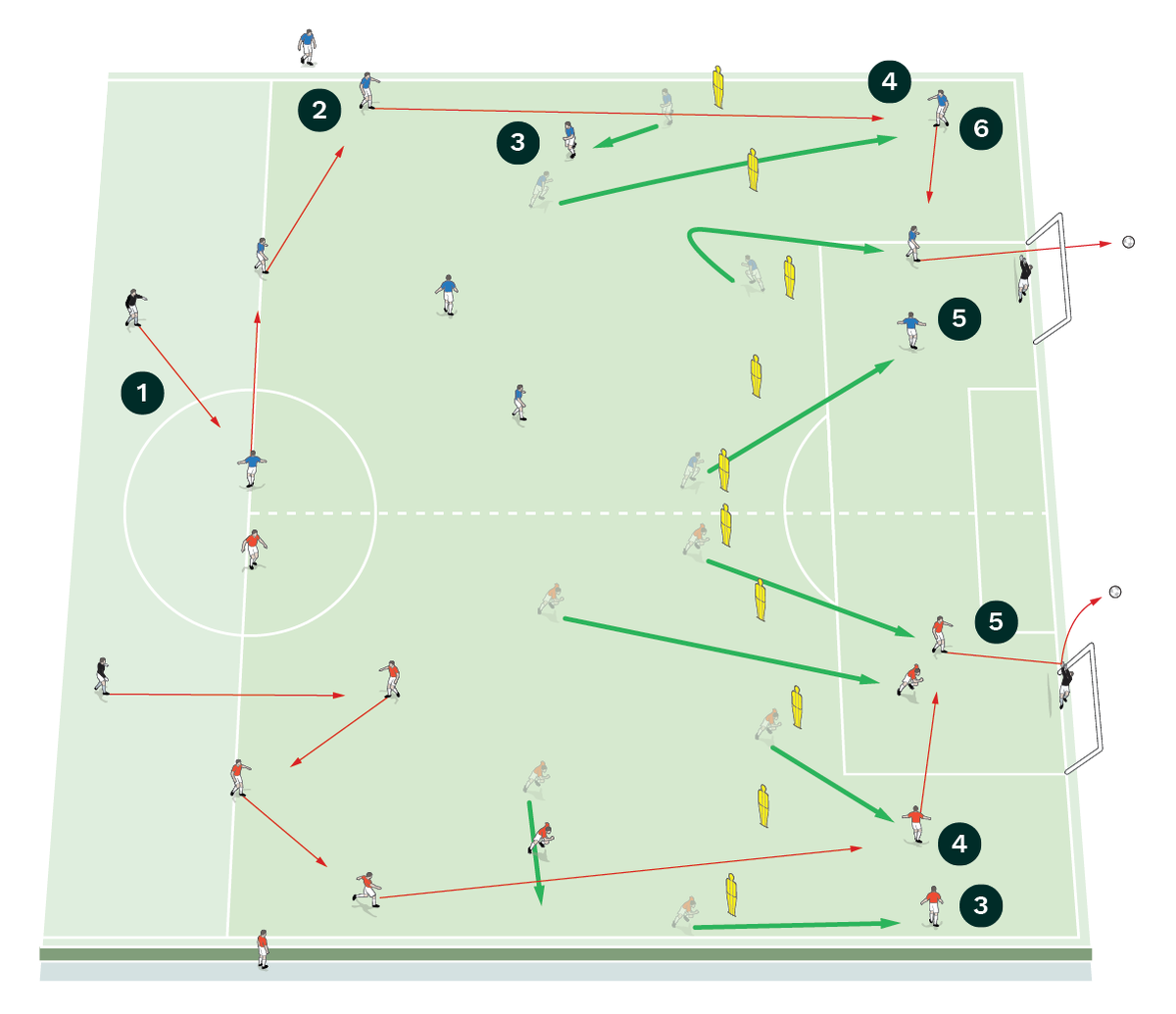
Captions 1 and 2 apply to both halves of the pitch
1. The ball starts with the goalkeeper near the halfway line on both sides
2. The goalkeeper, centre-backs and central defensive midfielder combine to work the ball to the on-pitch full-back on both sides
Top half
3. Number 9 shows feet, number 11 shows feet inside, number 8 makes movement beyond the full-back
4. The full-back plays the ball to the number 8
5. Number 9 and number 7 attack the box
6. Number 8 crosses for a finish
Bottom half
3. Number 9 makes a movement behind the centre-back, number 7 makes movement beyond the full-back
4. The full-back plays the ball to the number 9, who crosses the ball in
5. The number 11 and number 8 run into the box to meet the cross
The 9 may show feet for the ball or move behind the outside centre back, the 11 will either show feet outside or inside, the 7 will move beyond the wing back, the 10 will show feet outside or inside and the 8 will move beyond the wing back. The full-back should select the most positive available pass.
The player who receives the pass from the full-back then triggers the second specific movement from the other players.
The 9 may show feet for the ball, look to receive into space or attack the box, the 11 may support under the ball, continue to run behind or attack the box, the 7 may continue to run behind or attack the box, the 10 will continue to run behind, support under the ball or support to feet and the 8 may continue their run in behind, receive to feet or attack the box. The player in possession should select the most positive available pass.
Various different combinations are shown in the diagrams [1a, 1b. 1c, 1d].
We run two repetitions at match pace, then rest.
[1b]
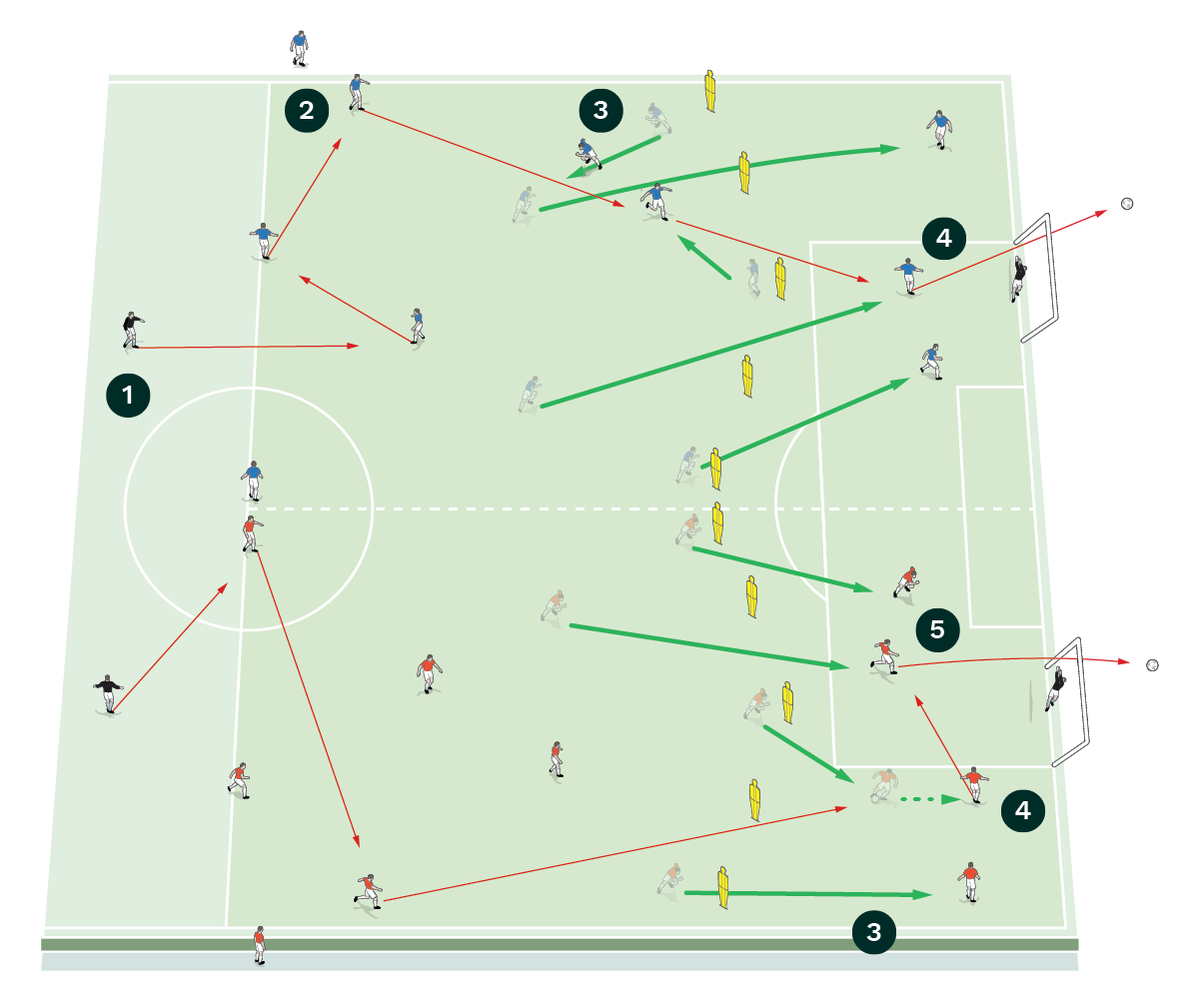
Captions 1 and 2 apply to both halves of the pitch
1. The ball starts with the goalkeeper on both sides
2. The goalkeeper, centre-backs and central defensive midfielder combine to work the ball to the on-pitch full-back on both sides
Top half
3. Number 9 receives the ball to feet, number 8 continues run behind, number 10 attacks the box, number 7 attacks the box, number 11 supports under the ball
4. Number 9 plays a through ball for the number 10, who shoots at goal
Bottom half
3. Number 7 continues run behind, number 8 attacks the box, number 11 attacks the box
4. Number 9 runs beyond the centre-back to receive in behind
5. Number 9 cuts back for oncoming number 8 who finishes
[1c]
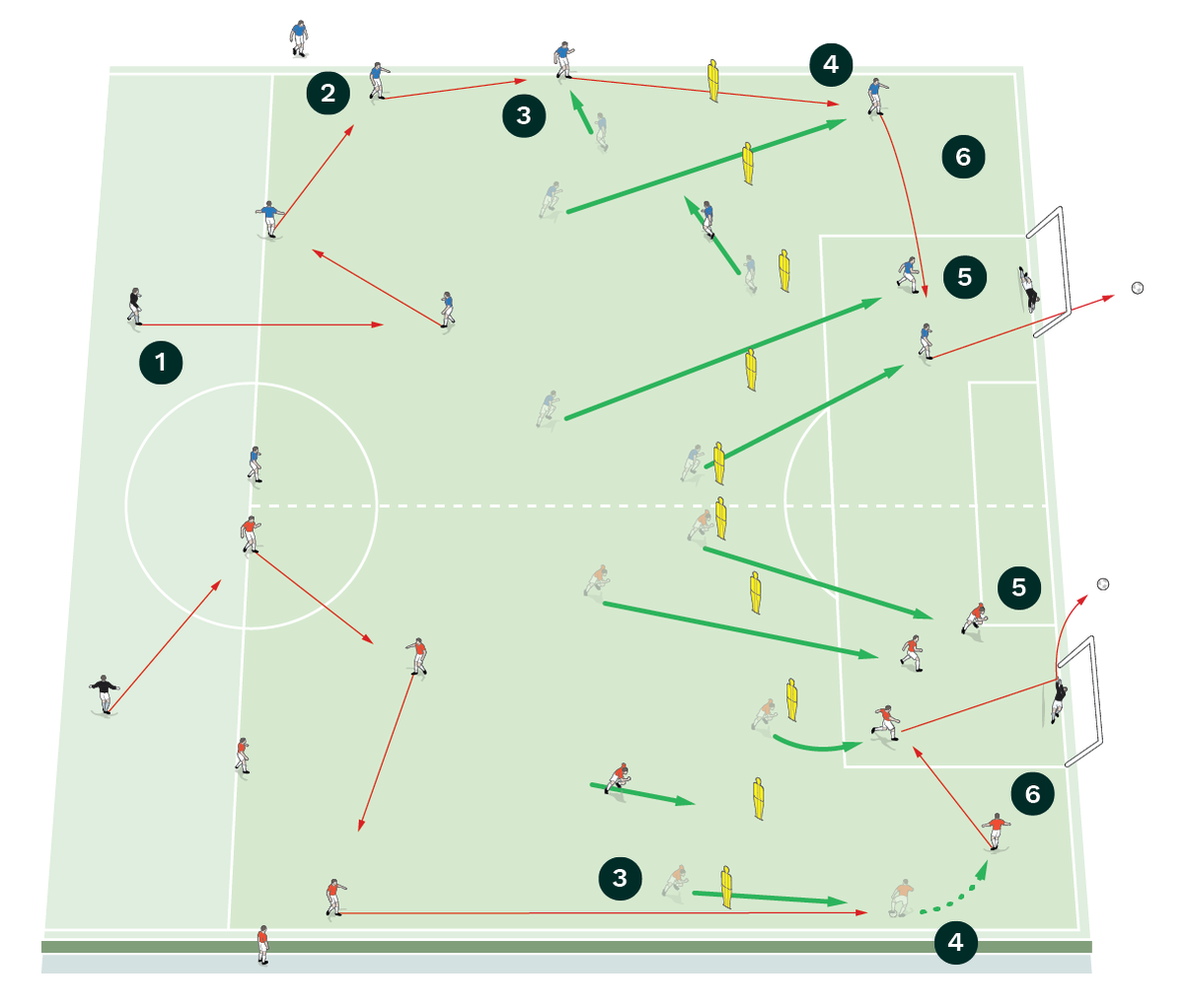
Captions 1 and 2 apply to both halves of the pitch
1. The ball starts with the goalkeeper on both sides
2. The goalkeeper, centre-backs and central defensive midfielder combine to work the ball to the on-pitch full-back on both sides
Top half
3. Number 11 receives the ball into feet, number 8 continues run beyond, number 9 supports to feet
4. Number 11 plays the ball to the number 8
5. Number 10 attacks the box, number 7 attacks the box
6. Number 8 crosses for a finish
Bottom half
3. Number 7 makes a run down the wing
4. Full-back plays the ball to the number 7
5. Number 10 supports from behind, number 9, 11 and 8 attack the box
6. Number 7 cuts back for the number 9 to finish
“I want my teams to keep possession to get opportunities to play forward so it’s important that my players play the most progressive pass available and don’t just play square and backwards”
[1d]
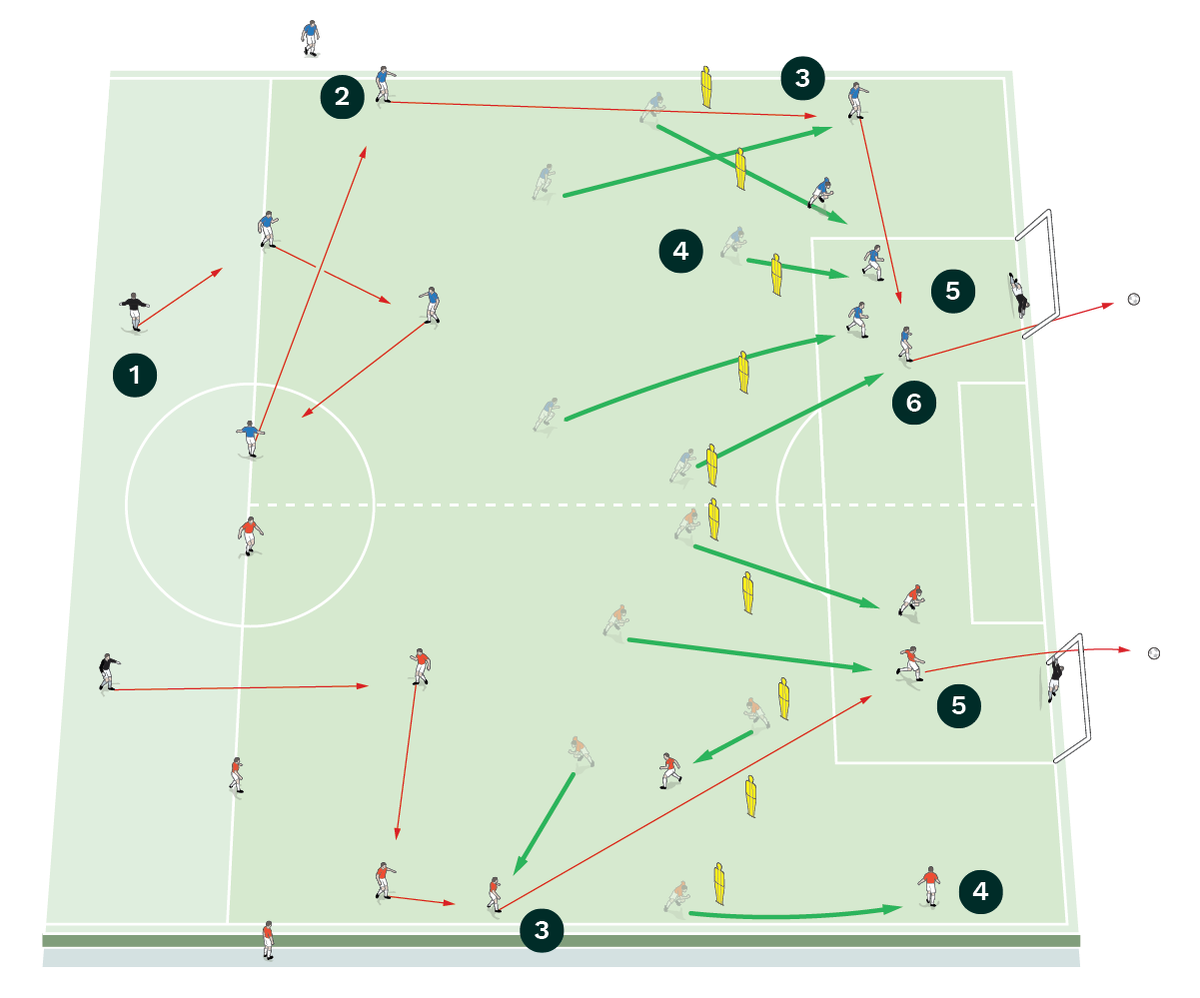
Captions 1 and 2 apply to both halves of the pitch
1. The ball starts with the goalkeeper on both sides
2. The goalkeeper, centre-backs and central defensive midfielder combine to work the ball to the on-pitch full-back on both sides
Top half
3. Number 8 runs to receive from the full-back in space
4. Number 11 supports from behind
5. Number 9, 10 and 7 attack the box
6. Number 8 crosses for the 7 to finish
Bottom half
3. Number 10 supports outside and receives the ball to feet
4. Number 7 runs behind, number 9 supports to feet, number 8 continues the run behind, number 11 continues the run behind
5. Number 10 plays a through ball for the number 9 to finish
CORE SESSION
We’re using the full pitch, with a full size goal at each end. There are 20 outfield players and two goalkeepers on each side as shown in the diagram.
For the first part, the attacking team is set up in a 4-3-3. The defending team, with 8 outfield players, is set up in a 5-3.
The defending team are mobile mannequins – they must passively defend and not challenge for the ball.
The ball starts with the goalkeeper, centre back or centre defensive midfielder who should work together to get the ball to one of the full-backs who will progress play from there. There is emphasis on decision making for the attacking team – they must use some of the patterns, triggers and actions practiced in the lead-in session [2a].
[2a]

- The reds line-up in a 4-3-3 formation, the blues are 5-3-0
- The blues must passively defend – they cannot challenge
- The ball starts with the goalkeeper near the halfway line
- They play the ball to the centre-back, who plays it to the full-back
- Number 9 comes inside to receive the ball to feet
- Number 10 supports under the ball and receives it
- Number 7 makes a run down the wing
- Number 11 attacks the box
- Number 8 makes a run in behind and receives a through ball from the number 10
- Number 8 finishes
For the second part, the attacking team is set up in a 4-3-3. The defending team now has 11 outfield players and is set up in a 5-3-2.
The game is now competitive – the defending team can compete for the ball.
The ball starts with the goalkeeper, centre back or centre defensive midfielder who should work together to get the ball to one of the full-backs who will progress play from there. There is even more emphasis on decision making for the attacking team, they must now work some of the patterns, identify some of the triggers and complete some of the actions against a live defence [2b].
[2b]

- The reds line-up in a 4-3-3 formation, the blues are 5-3-2
- The blues are now active opposition
- The goalkeeper starts with the ball, playing it to the central defensive midfielder, who plays it to the full-back
- Number 11 makes a run beyond
- The full-back plays the ball to the number 11
- Number 8 supports behind the ball
COACHING POINTS
What are the key things to look out for?
- Full-back preparing first touch in order to be able to play every pass
- Detail of movement – timing/direction/double movements/speed
- Detail of pass – strength to allow the receiving team-mate to play one or two touch and destination - back foot, front foot or space
- Awareness – recognise movement of support players and opposition
- One-touch pass – both to feet and space
- Reaction – from others and opponents’ movements
- Decision-making – with review afterwards
- Tempo – when to speed up or slow down play to break the opposition
- Make the most positive pass – create opportunities to threaten goal
What are the typical mistakes players might make and how do I avoid them?
I want my teams to keep possession to get opportunities to play forward so it’s important to me that my players play the most progressive pass available to them and don’t just play square and backwards.
Also, tempo of play is a necessary, therefore my players are encouraged to play in fewest touches possible (unless driving with the ball or attacking 1v1). To play the style of play I demand, players need to have awareness - of the opponent, their team-mates and the space - as they are expected to play this way when under a high press from the opposition.
To improve in these areas, I review and reflect with individuals, units and the team as a whole.
Related Files
Editor's Picks
Attacking transitions
Deep runs in the final third
Using the goalkeeper in build-up play
Intensive boxes drill with goals
Penetrating the final third
Creating and finishing
My philosophy
Pressing initiation
Compact team movement
Coaches' Testimonials

Alan Pardew

Arsène Wenger

Brendan Rodgers

Carlos Carvalhal

José Mourinho

Jürgen Klopp

Pep Guardiola

Roy Hodgson

Sir Alex Ferguson

Steven Gerrard
Coaches' Testimonials

Gerald Kearney, Downtown Las Vegas Soccer Club

Paul Butler, Florida, USA

Rick Shields, Springboro, USA

Tony Green, Pierrefonds Titans, Quebec, Canada
Join the world's leading coaches and managers and discover for yourself one of the best kept secrets in coaching. No other training tool on the planet is written or read by the calibre of names you’ll find in Elite Soccer.
In a recent survey 92% of subscribers said Elite Soccer makes them more confident, 89% said it makes them a more effective coach and 91% said it makes them more inspired.
Get Monthly Inspiration
All the latest techniques and approaches
Since 2010 Elite Soccer has given subscribers exclusive insight into the training ground practices of the world’s best coaches. Published in partnership with the League Managers Association we have unparalleled access to the leading lights in the English leagues, as well as a host of international managers.
Elite Soccer exclusively features sessions written by the coaches themselves. There are no observed sessions and no sessions “in the style of”, just first-hand advice delivered direct to you from the coach.
